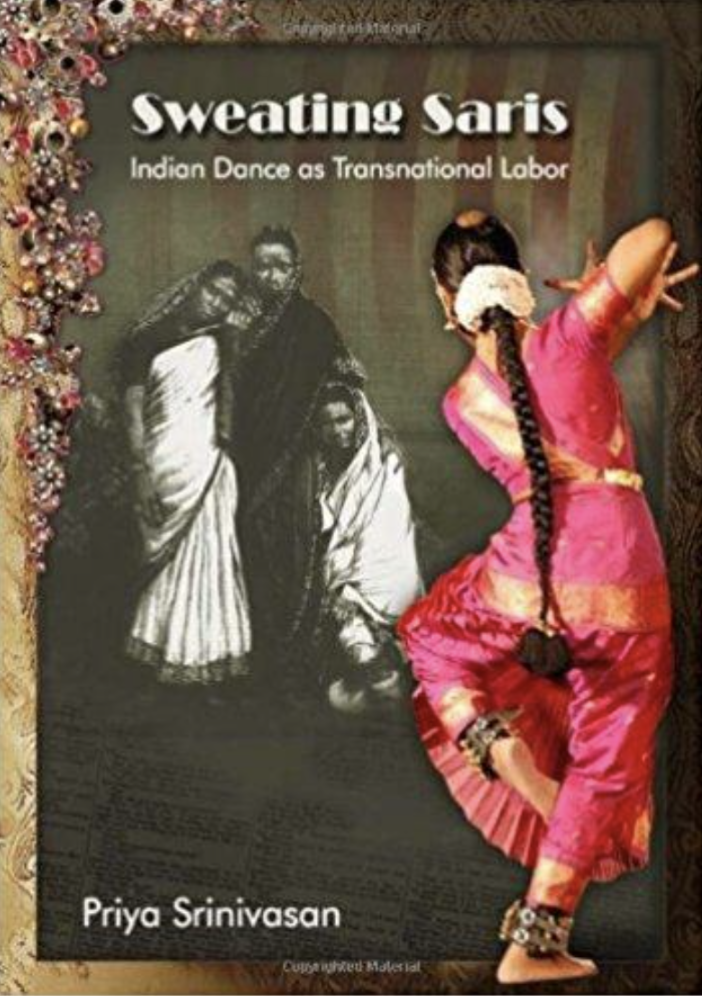Sweating Saris
An interactive multimedia duet between Ramya Harishankar and Dr. Priya Srinivasan, this piece explored the ways that performance as research can come alive from page to stage.
about it
Based on Srinivasan's book "Sweating Saris: Indian Dance as Transnational Labor" which examines the history of Indian dance from 1880 to the present in the US in relation to restrictive anti-Asian immigration policies (between 1924-1965), the performance featured her long relationship with Harishankar and, her students, as well as teaching processes while questioning dance not just as an aesthetic form but its relationship to socio-political, historical, cultural, racialized, and gendered forms of power. While audiences of Bharata Natyam often see dance as a polished product, Sweating Saris exposes dance as a form of labor. The piece uses postmodern frameworks and structured improvisation (which is part of both Indian/ contemporary dance) to unpack what is often unsaid, unseen, invisible and foreground the "behind the scenes" including the ways in which the book was created.
Choreography by Ramya Harishankar and Dr. Priya Srinivasan with Susan Rose


Performances
Dance Conversations Symposium, Irvine City Hall, Irvine, CA
Presented by Ektaa Center & the Arpana Dance Company
Dhvani, Columbus, OH
Spaces, Chennai, India
Highways Performance Space, Santa Monica, CA
Mosaic Silicon Valley & Sangam Arts, Campbell, CA
Stanford University, Stanford, CA
Presented by Dept of Film Studies and Center for South Asia
San Diego State University, San Diego, CA
Presented by the Department of Women's Studies & the School of Music and Dance.
Kelly Ethnic Cultural Center Theater, University of Washington, Seattle, WA
Presented by the South Asia Center, the Dance Department, the Simpson Center for the Humanities, the BA in Culture Literature, and the Arts (CLA), Global Studies (GST), Society Ethics and Human Behavior (SEB), and MA in Cultural Studies (MACS) at the School of Interdisciplinary Arts and Sciences at the University of Washington, Seattle & Bothell.
Narthaki online, Sept 2016
…...a very successful and thought-provocative “Performance as Research” creative choreography entitled, “Sweating Saris”, based on Priya Srinivasan’s award-winning book Sweating Saris: Indian Dance as Transnational Labor (Temple University Press, 2012)…………. This historical backdrop to the “performance as research” was conveyed and interrupted in effective post-modern ways, by Priya herself taking on her different autobiographical roles with a wonderful sense of humor and levity involving the audience as participants on her journey. First, she plays being a student of Bharatanatyam in Melbourne Australia under Guru Dr. Chandrabhanu, the rigors of that teacher-student relationship fraught as such relationships often are, with issues of labor and power, then transforming to another stage of her academic life when she came to Ramya’s studio to observe her teaching, then taking class with her. Ramya as guru, played out how her teaching transpires in the Diaspora to American-born students of Bharatanatyam. Ramya’s knowledge of certain padams and javalis, her melodious singing voice in Carnatic style were all inspiring modalities for translating the meaning and movements of the old padams to her modern students.
The point is made subtly that there is use of improvisation both in traditional Indian dance as well as in contemporary dance, and that it is as important to revisit, deconstruct, unpack the wealth in traditional forms as it is to remain open to the wealth of movement and sound styles in a globalized world that we all inhabit in the 21st century.
Ketu H. Katrak, University of California, Irvine
Sruti Magazine blog, Sept 2016
Very cerebral, yet humorous and provocative, Sweating Sarees….the multimedia presentation evolves as a conversation with the audience. Together they explore the historical significance of Bharatanatyam as it reemerges in the 20th century in India and later spread across the world with the dispersing population. Notable here was Priya’s dance evocative of her efforts as a student in Australia; and later, her earnest explorations seeking a deeper understanding in her interactions and study with Ramya.
Ramya’s own story as narrated, of her emergence as a dancer and teacher, are touchingly personal. Her singing seated while doing abhinayam to the most exquisitely delicate padams reminds us of a world we have perhaps lost. Rich poetry sung to haunting melodies with nuanced emotions and detailed and etched movements; she brought us glimpses of that old world natyam that we don’t often see today.
At times, they were able to communicate their message without the words that seem to be ubiquitous in the world of Bharatanatyam today.
Shankar Ramachandran

